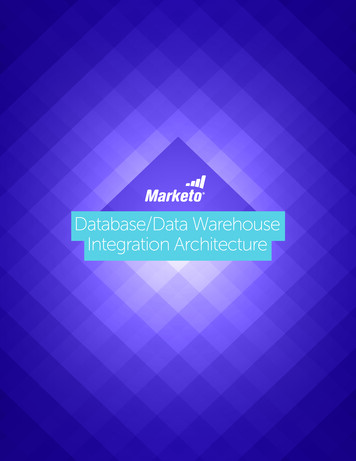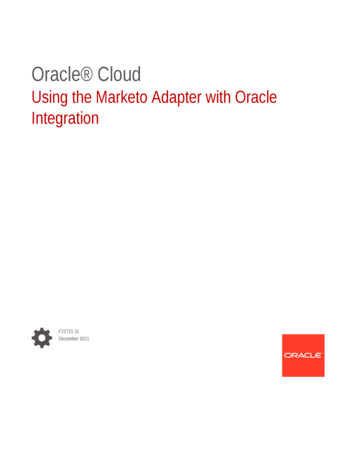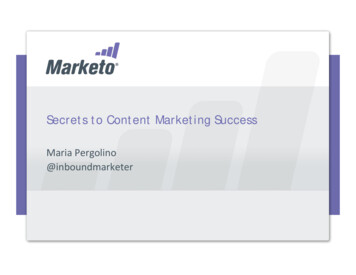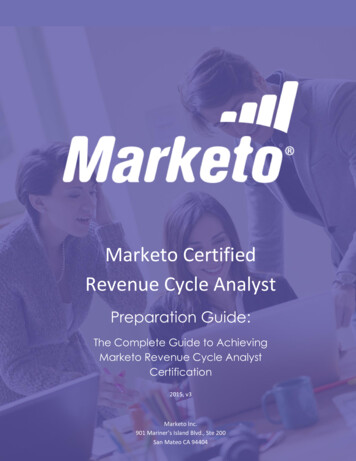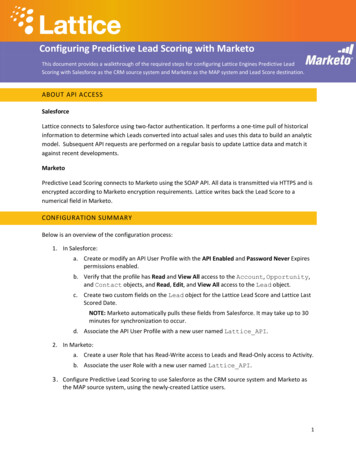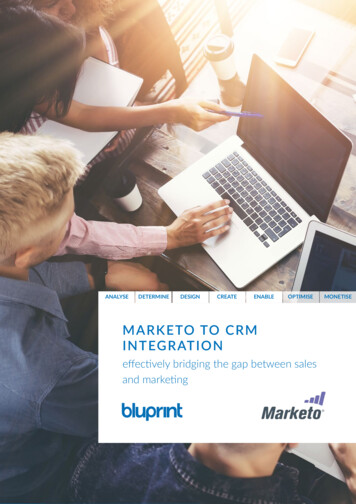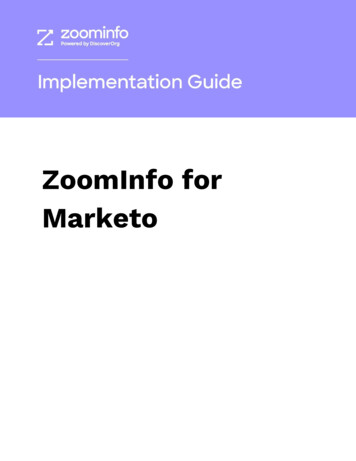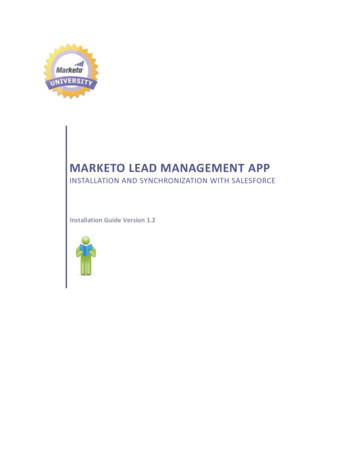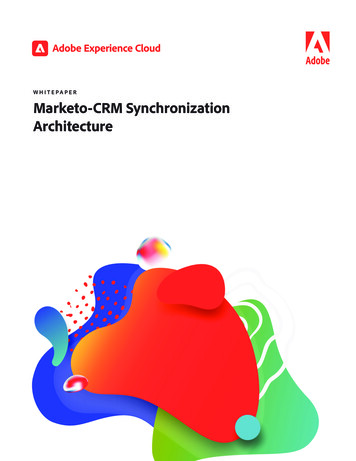
Transcription
W H I T E PA PE RMarketo-CRM SynchronizationArchitecture
Table of ContentsIntroduction4Revision History4V1 – April 20164V2 – June 20184V3 – March 20214Overview5Notes on Terminology5Additional Reading5Typical Synchronized Entities6Leads6Companies8Opportunities9Opportunity Roles11SalesPersons11Extended Synchronized EntitiesCustom ObjectsActivitiesCustom ActivitiesProgramsProgram MembershipStatic 819191919Synchronized FieldsSynchronized Custom ObjectsSynchronized Activity TypesBootstrapping Configuration
Table of ContentsSynchronization Interval19Bootstrapping from Marketo20LeadsCompaniesOpportunities and RolesSalesPersonsCustom ObjectsPrograms and MembershipActivitiesLists and MembershipRecommended Bootstrapping OrderMaintaining SynchronizationRecommended Synchronization OrderLeads and CompaniesSalesPersonsOpportunities and RolesActivitiesCustom ObjectsLead ConversionConverting a Lead to a Contact in a new CompanyConverting a Lead to a Contact in an Existing CompanyConverting a Lead into an Existing Contact RecordProgram-Opportunity AttributionFirst-Touch Attribution (FT)Multi-Touch Attribution On-Demand Synchronization26Marketo Data Retention Policy27
IntroductionThis document aims to provide detailed information regarding implementation of a synchronizationarchitecture between Marketo and an external CRM system. Entities are described, and the specifics ofperforming initial synchronization, or “bootstrapping,” and maintaining synchronization of new and updatedrecords.Revision HistoryV1 – April 2016 Initial releaseV2 – June 2018 Updated Reference Architecture to reflect usage of Bulk APIs as preferred synchronization method. Corrected typos. Updated list of activities pruned after 90 days. Additional diagrams for lead qualification, webhook push. Added Marketo Data Retention Policy sectionV3 – March 2021 Updated for latest changes platform, nomenclature, and APIsMarketo-CRM Synchronization Architecture4
OverviewThis document assumes that the reader has basic familiarity with the Marketo Engagement Platform CoreApplications, a working knowledge of REST APIs in general, and familiarity with the concepts of a CRM and aMarketing Automation platform.Marketo recommends implementation of CRM synchronization applications using a two-way polling model,retrieving changes and new records from either system, and pushing those changes as mapped in theapplication configuration to the other system. The middleware system should query for changes of selectedrecord types periodically and then perform any necessary translation and filtration before pushing the recordupdates to CRM or Marketo, respectively.Notes on TerminologyWhile in most product areas, Marketo now refers to lead, contact, and prospect records as “People” or“Persons,” this document uses terms such as “Lead,” “Contact,” and “Person” interchangeably to refer to recordswhich represent a single human entity.Additional ReadingIn addition to what is described in this document, architects and implementors would be well advised to doadditional reading on the specifics of using the Marketo REST and Bulk APIs. Useful documents include: Getting Started REST API Best Practices Performance Error CodesMarketo-CRM Synchronization Architecture5
Typical Synchronized EntitiesA minimally functional CRM integration with Marketo will provide two-way synchronization of Leads, andCompanies, and one-way CRM-to-Marketo integration of the following entities: Opportunities Opportunity Roles SalesPersonsGlobal Notes for Object ModelsSome object schemas in Marketo are dynamic and user-editable, so it is extremely desirable to allow dynamicupdates to the schema, this should as a routine part of a synchronization cycle. For these types of objects, aDescribe {Object} endpoint is made available, which will return all the fields available to the Marketo APIs,along with datatype and length information where applicable. Where available, the Describe endpoint shouldbe used as the exclusive source of truth for the object schema. Administrative users should be permitted toadd, remove and alter mapping for non-ID fields at any time.For Marketo’s data type definitions, please refer to this document.LeadsPrimary Key: idThe integer id of a Marketo lead record and the primary key. This is system managed by Marketo and mayonly be assigned by Marketo. Any insert operations attempted by a foreign system which include id will berejected.In Marketo leads represent any person-record which represents a sales or marketing target. They are distinctfrom sales person records, which own and have responsibility over lead records. All Smart Campaigns,commonly referred to as a workflow in non-Marketo systems, filter, trigger, and operate on lead records,based on their characteristics and actions. Unlike most typical CRM systems, Marketo does not have twoseparate record types for Lead and Contact records, rather, each Person in Marketo has additional fields whichmatch those available for Companies. The distinction between contacts and leads is logically represented bywhether a value is present in the field “externalCompanyId.” If set, then the record is a member of a company.The set of company type fields on a company record is no longer updateable when the externalCompanyIdfield is set for that record and needs to be deferred to the linked company record, instead of modified throughthe person record.Marketo-CRM Synchronization Architecture6
ModelLeads are highly extensible in Marketo and may include an unlimited number of custom fields. Whensynchronizing any subscription, a set of standard fields should not be relied upon, and the Describe Leadfunction of the REST API should be used as the exclusive source of truth to determine field availability andupdateability in a particular subscription.The model for a lead is also potentially dynamic, as fields may be added or hidden by end-users at any time,so the schema of lead records should be maintained whenever a synchronization cycle is initiated.A custom lead field should be created in Marketo to hold the primary key of the CRM, in order to permitunambiguous upsert operations for lead records.MappingLead field mapping should be determined by the available person types in the CRM system. A typical CRMimplementation would only include Leads and Contacts would be mapped to the logical corresponding fieldfor each record type. When possible a suggested list of mappings should be given for fields which are knownin both Marketo and the CRM, but users should be allowed to change these field mappings freely to accountfor different usages. If leads are mapped to multiple object types, then mappings for each type should beallowed to be mapped independently. It is possible and sometimes desired to have leads mapped to multipletypes of records, differentiating the type based on a custom CRM type string field, referring either to the ID ofthe record type, or a plaintext string representing the type.RelationshipsLeads are related to numerous accessible object types in Marketo:ObjectRelationship TypeLink TypeLink FieldCompanyN:1Lead FieldexternalCompanyIdSalesPersonN:1Lead y Role ObjectleadIdCustom Objects1:N, N:1, or N:NSee Custom ObjectSectionSee Custom ObjectSectionActivities1:NActivity FieldleadIdProgramN:NProgram MembershipObjectSee Program MembershipMarketo-CRM Synchronization Architecture7
AccessibilityLeads may be read and written to freely in Marketo provided that the Read-Write Lead Permission has beenawarded to the API user being used. Leads can be read through the following endpoints: Bulk Lead Export Get Lead by ID Get Multiple Leads by Filter Type Get Multiple Leads by List Id Get Multiple Leads by Program IdLeads can be written to through the following endpoints: Import Lead Push Lead Create/Update LeadsLead Records may be merged through the Merge Leads endpoint. A discussion of this endpoint’s behaviormay be found here.Leads may be deleted through the Delete Leads endpoint.Lead Metadata is read through the Describe Lead endpoint.CompaniesPrimary Key: externalCompanyId, idexternalCompanyId is an arbitrary string field set upon creation by the external system. It is guaranteed to beunique and is not updateable. Id is a unique system-generated integer id.Company objects represent the organization to which lead records belong. Leads are added to a Company bypopulating their corresponding externalCompanyId. Leads linked to a company record will directly inherit thevalues from a company record as though the values existed on the lead’s own record. Attributes available onthe company record are available for triggering and filtering on lead records from within the application.Company records may only be created by external systems, and the CRM should be treated as the source oftruth, except when changes to company records are detected in Marketo.Marketo-CRM Synchronization Architecture8
Model Companies are fully extensible and may have any number and type of custom fields Schema should be dynamic and capable of ingesting or evicting fields from the model at any time. Theschema should be refreshed with Describe Company as a routine part of synchronization. Describe Company should be used as the exclusive source of truth for the schema of companyMappingCompany records in Marketo should be mapped to an equivalent object type in CRM. These are typicallyreferred to as Companies, Accounts, or Organizations, but terminology may vary for different CRMs. Usersshould be allowed to edit the mappings of Marketo Company fields to CRM Company fields.The primary key of company records in CRM should be mapped to the externalCompanyId field wheneverpossible.RelationshipsObjectRelationship TypeLink TypeLink FieldLead1:NLead FieldexternalCompanyIdOpportunity1:NOpportunity FieldexternalCompanyIdSalesPerson1:NSalesPerson FieldexternalSalesPersonIdAccessibilityIn order to read and write to company records, an API user must have the Read-Write Companypermission. Companies may be read through a single endpoint, Get Companies by Filter Type. Companies may onlybe filtered on a limited number of fields, which are provided in the searchableFields attribute of theDescribe Company result. Companies can be written to using the Create/Update Companies endpoint. Companies may be deleted through the Delete Companies endpoint.OpportunitiesPrimary Key: externalOpportunityId, marketoGUIDexternalOpportunityId is an arbitrary string field which is set upon creation by the external system. It isguaranteed to be unique and is not updateable. marketoGUID is a system generated GUID string which isguaranteed to be unique.Opportunity objects loosely represent sales deals in Marketo, and are responsible for attributing revenueto leads, companies and programs. Opportunity usage varies between both CRM implementations andorganizational implementations, so they may encompass anywhere from a sales deal complete with individualline items to broader records of sales efforts. It may not be possible to accommodate an organization’s usecases for tracking sales deals through the implementation opportunities alone, so additional extensionthrough Custom Objects may be required.Marketo-CRM Synchronization Architecture9
To perform proper Revenue Attribution, Opportunities must be linked to leads via roles, and linked tocompanies via the externalCompanyId field. For information on Revenue Attribution, please see the ProgramOpportunity Attribution section.ModelLike leads and companies, opportunities have a flexible and user extensible schema, which should beroutinely updated through the Describe Opportunity endpoint.MappingIn general, the same mapping strategy should be employed for Opportunities as Leads and Companies, butOpportunities have some special-case fields which should be mapped with care: The “Amount” field in Marketo is the field from which all revenue calculations are made and shouldalways be mapped to the Opportunity field which represents the estimated amount of the proposed dealbefore close, and the realized amount of the deal after close. The “Revenue Expected” metric is the product of Amount and Close Probability. The Close Probabilitypercentage is multiplied against Amount to return Revenue Expected. Stage has a set of calculated values based on the “Closed” and “Won” fields on opportunity records.Closed should be set to true if the sales deal is no longer being pursued, either because the effort failed,or because the deal was won. Won should be set to true only if Closed is also true and the deal has beenwon. Different CRMs may treat these characteristics differently, and so they may require translation fromthe system.externalOpportunityId should be mapped to the primary key in the CRM whenever possible.externalCreatedDate should be mapped to the CRM system’s canonical creation date for opportunities.RelationshipsObjectRelationship TypeLink TypeLink FieldCompanyN:1Opportunity FieldexternalCompanyIdLeadN:NOpportunity Role ObjectleadIdProgramN:NSee Program-OpportunityAttribution sectionSee Program OpportunityAttribution sectionAccessibility In order to read and write to opportunities, an API user must have the Read-Write Opportunitiespermission. Opportunities can be read via the Get Opportunities by Filter Type endpoint. Like companies,they have a limited set of searchable fields which can be retrieved via the Describe Opportunityendpoint. Opportunities may be created or updated via the Create/Update Opportunities endpoint. Opportunities may be deleted through the Delete Opportunities endpoint.Marketo-CRM Synchronization Architecture10
Opportunity RolesPrimary Key: Compound Key [leadId, role, externalOpportunityId], marketoGUID.Opportunity roles have a compound key of leadId, role, and externalOpportunityId. leadId andexternalOpportunityId are relationship fields to their respective lead and opportunities. To insert a record, orupdate it via its dedupeFields key, all three fields must be passed in the record. marketoGUID is a unique GUIDstring, which is system-managed and generate on creation of the record.Opportunity roles are link objects from lead records to opportunity records. Without this relationship, leadswill not be associated to Opportunities in any way. They are also required relationships to perform end-to-endProgram Opportunity Attribution.ModelThe schema for Opportunity Roles is non-extensible and should be derived from the Describe OpportunityRole endpoint once. Primary contacts on an opportunity are designated in Marketo by the isPrimary flagon the opportunity role. If the primary contact concept exists in the CRM being integrated, this should beimplemented as part of the model and mapping.MappingisPrimary should be matched if there is a concept of primary contacts in the CRM being integrated.externalCreatedDate should be mapped to the canonical date in the CRM which corresponds to the date thata person became a member of the opportunity.RelationshipsObjectRelationship TypeLink TypeLink FieldLeadN:1Opportunity Role FieldleadIdOpportunityN:1Opportunity Role FieldexternalOpportunityIdAccessibility To read and write opportunity roles, an API user must have the Read-Write Opportunities permission. Opportunity Roles can be read via the Get Opportunity Roles by Filter Type endpoint. Like companies,they have a limited set of searchable fields which can be retrieved via the Describe Opportunity endpoint. Opportunity Roles may be created or updated via the Create/Update Opportunity Roles endpoint. Opportunity Roles may be deleted through the Delete Opportunity Roles endpoint.SalesPersonsPrimary Key: externalSalesPersonId, marketoGUIDexternalSalesPersonId is an arbitrary string field set upon creation by an external system. marketoGUID is aunique system managed GUID string which is set upon creation by Marketo.Marketo-CRM Synchronization Architecture11
SalesPersons represent an internal entity which has ownership of a set of person records, typically for salespurposes. The information present on these records is used to derive certain formula fields and tokens for leadrecords in Marketo.ModelThe schema for SalesPersons is non-extensible and should be read once from the Describe Sales Personendpoint.MappingexternalSalesPersonId should be mapped to the primary key for the corresponding user or owner object typein the integrated CRM.RelationshipsObjectLeadCompanyRelationship Type1:NN:1Link TypeLead FieldCompany FieldLink bilityIn order to read and write to sales persons, an API user must have the Read-Write Sales Person permission.Sales persons can be read via the Get SalesPersons by Filter Type endpoint. Like companies, they have alimited set of searchable fields which can be retrieved via the Describe SalesPersons endpoint.SalesPersons may be created or updated via the Create/Update SalesPersons endpoint.SalesPersons may be deleted through the Delete SalesPersons endpoint.Marketo-CRM Synchronization Architecture12
Extended Synchronized EntitiesCustom ObjectsPrimary Key: marketoGUID, Additional User Defined keysNote: This section refers to Marketo-originated custom objects, not to those sourced from one of the NativeCRM Sync ConnectorsCustom objects always have a unique system-generated marketoGUID which is set upon creation. There willbe at least one additional key, and possibly more, which are user-defined in the custom object definition. Keysmay be single fields for types which are linked directly to leads or companies and may have compound keysfor types which are linked to leads or accounts and another custom object type. Keys can be determined byusing Describe Custom Object to retrieve the list of dedupeFields.Marketo allows the definition of Custom Object types by users to extend the Marketo schema. Marketocustom objects may be related to leads or companies, in either a one record to many custom objectconfiguration, or a many-to-many configuration through the usage of intermediate custom objects.ModelThe schema for custom objects is dynamic. Each custom object may have any number of fields which mayupdated.MappingCustom object mapping should be driven by customer requirements and cannot be rigidly defined ingeneral terms.RelationshipsMarketo Custom Objects may only be related to either leads or companies, in either a 1:Nconfiguration or N:N configuration through the usage of intermediate custom objects. Relationshipscan be derived from the relationships parameter of the result of Describe Custom Object.Marketo-CRM Synchronization Architecture13
AccessibilityTo read and write to custom objects, an API user must have the Read-Write Custom object permission. Customobjects have the standard set of Get, Create/Update, and Delete endpoints. A List Custom Objects endpoint isalso provided to a give a means of determining what custom object types are available in each subscription.ActivitiesPrimary Key: marketoGUID, idActivities have a unique GUID that is set upon creation by Marketo.Activities are records of activities associated to lead records in Marketo. They may record activity of manydifferent types, as indicated by their activityTypeId. Activities are read-only in Marketo. Certain activitytypes are pruned after 90 days in the Marketo system outside of the standard data retention policy. PrunedActivities: Add to ListChange ScoreChange Data ValueVisit WebpageClick Link on WebpageSync Lead to SFDCSync Lead to MicrosoftSync Lead Updates to SFDCUpdate OpportunityRequest CampaignEmail Delivered*Send Email** Email Delivered and Send Email activities changed from 25 months to 90 days effective August 31st, 2020. Moreinformation here.The types of activities available in each subscription are variable depending on many factors, including typeof subscription. The available types and their metadata should always be determined by calling Get ActivityTypes from the target subscription.Standard activities in Marketo are read-only and cannot be updated.ModelActivities have a semi-strict schema. The following fields are defined, but not necessarily used for all ringUnique tetimeId of the linked lead. Maps to id on lead recordsId of the type of activity corresponding to a result of Get ActivityTypesDate that the activity occurredprimaryAttributeValueStringValue of the primary attributeprimaryAttributeValueIdIntegerId of the primary attributeattributesArrayArray of name/value pairs representing the attributes of the activityMarketo-CRM Synchronization Architecture14
Each activity type has a primary attribute which corresponds to a value of some kind. The attribute may berelated to any type of asset or object type in Marketo. For example, the primaryAttributeValue of the VisitsWeb Page type corresponds to the name or URL of the web page which was visited. The Marketo name will bepresented if the page was a landing page, and the URL if it is not a Marketo page. Attributes consists of an arrayof name/value pairs, naming each of the fields for an activity type and the corresponding value.Activities may be modeled as either a single object type with an array of attributes, or as individual objecttypes, depending on the requirements or best practices for the external CRM system.RelationshipsActivities in Marketo are always related to lead records through the leadId field. Some activity types may havea relationship to other Marketo assets through their primaryAttributeValue.AccessibilityIn order to read activities, an API user must have the Read-Only Activity permission. To write custom activitiesthe Read-Write Custom Activities permission is required.Activities can be read through the following methods: Bulk Activity Export Get Lead Activities Get Lead Changes Get Deleted LeadsCustom ActivitiesCustom activities help you track an activity that is outside the Marketo standard out-of-box activities, suchthose related to form fill, email, or landing page.Want to track when someone deposits a check? Use a custom activity. Want to keep tabs on when someoneattends a webinar? Use a custom activity.Reference the documentation on Custom Activities here. Custom Activities may be written through theCustom Activities endpoint documentation referenced here.ProgramsPrograms in Marketo are both a primary organizational asset and a key attribution component. Programsare representational of high-level marketing strategies, individual marketing tactics, and operationalworkflows. Each program may encapsulate marketing collateral, and Smart Campaigns/workflows.Opportunity-related revenue is attributed to programs based on a lead’s relationship to a program,represented either by the Acquisition Program lead field, or by a lead’s program membership in thatprogram.It is a common practice in CRM integration for a program not to be directly represented in CRM but to betranslated to another type of object. For example, in Marketo’s native SFDC synch, the Program is mappedto the Campaign type, and the Program’s membership is mapped to the Campaign Membership type.Marketo-CRM Synchronization Architecture15
ModelThe schema for programs is mostly static. The number of fields available for program records will not change,but the Channels and Tags have user customizable values, which should be modeled if choosing to allowcreation of new programs from CRM to Marketo. A program will have the following fields:NameDatatypeDescriptionidIntegerUnique id of the programnameStringUser-defined namedescriptionStringUser-defined descriptioncreatedAtDatetimeDate of creationupdatedAtDatetimeDate of last updateurlurlUrl of the program in the subscriptiontypeStringType of the program, one of: Default, Event, Event with Webinar, Nurture,or EmailchannelStringChannel of the program. Defines acceptable statuses for programmembershipfolderObjectParent folder of the program.statusStringStatus of the program.workspaceStringParent workspace of the programtagsArrayArray of user-defined tags. Tags provide customizable information forprograms.costsArrayArray of costs. Used to define costs related to running a program.MappingThe CRM to be integrated may have an object type which maps to the Marketo program naturally. Programsbroadly represent marketing efforts and are linked to leads through the Program Membership object whichdefines the lead’s status, and success in the marketing effort.RelationshipsPrograms are related to leads through the Program Membership object. Programs also have otherrelationships to assets which are not pertinent to the discussion of CRM integration.AccessibilityTo read programs, the Read-Only Asset permission is required. Programs can be read through BrowsePrograms, Get Program by Id, Get Program by Name, and Get Program by Tag Type.To write programs, the Read-Write Asset permissions is required. Programs can be created through CreateProgram, can be update through Update Program, cloned through Clone Program, and Deleted throughDelete Program.Program MembershipPrimary Key: Compound [Id of Program, Id of Lead]Marketo-CRM Synchronization Architecture16
The primary key for program membership is a unique compound key of the id of the linked program and theid of the linked lead. There may only be one program membership record for each unique pair.Program Membership represents a lead’s relationship to a program and their status in that program. INaddition, Program Member custom fields allow you to collect/specify program-specific data for each member.They can be used in: Marketo forms, Smart List filters and triggers, and Smart Campaign flow actions, and APIcalls. The data is viewable in the Program Members tab.ModelProgram Membership has a strict schema. In relation to CRM some fields may be considered optionaldepending on customer requirements. Stream, isExhausted and nurtureCadence will only be populated whenthe membership record is related to a Nurture Program and may not have external relevance.NameDatatype DescriptionprogressionStatusStringStatus of the lead in the parent programStreamStringName of the stream that the lead is a member ofnurtureCadenceStringCadence of the lead in a nurture program. Either Normal or PausedisExhaustedBooleanWhether the lead is exhausted in its current Nurture StreamacquiredByBooleanWhether the lead was acquired by the parent programreachedSuccessBooleanWhether the lead is in a success status in the parent programreachedSuccessDateDatetimeThe date that the lead became successful in the programmembershipDateDatetimeThe date the lead became a member of the programProgram MemberAsDefinedProgram Member Custom Fields defined in Marketo Admin forCustom FieldsField ManagementThe id of the parent program and of the parent lead are not explicitly returned by Get Leads by Program Id,but are inferred by the given program id, and the returned parent lead.MappingLike programs, program membership may have a natural mapping to an existing object type but may alsoneed to be represented by a custom object type in the integrated CRM.RelationshipsProgram membership is related to programs and leads by their respective ids.AccessibilityReading and writing program membership requires the Read-Write Lead permission. Program membershipmay be read through Get Leads by Program Id and written through Change Lead Program Status.Marketo-CRM Synchronization Architecture17
Static ListsPrimary Key: idStatic lists have a unique system-managed integer id which is set at creation.Static lists represent arbitrary groupings of lead records in Marketo. Static lists can be created by usersusing the UI or programmatically via REST API. Static lists may or may not be important in external systemsdepending on customer requirements and have an extremely broad set of usages. Static lists are used toflexibly represent groups of people.ModelStatic lists have a strict schema defined below.NameDatatypeDescriptionIdIntegerUnique IdNameStringUser-defined nameDescriptionStringUser-defined descriptionprogramNameStringName of the parent program if applicablecreatedAtDatetimeDate the list was createdupdatedAtDatetimeDate the list was last updatedList Membership is defined as a simple record containing the id of the parent list and the id of the parent lead.MappingStatic lists and their membership may have a natural corollary in the targeted CRM.RelationshipsStatic lists are related to leads through the list membership object containing the id of both the lead and thelist.AccessibilityMarketo offers a set of REST APIs for performing CRUD operations on static lists. These APIs follow thestandard interface pattern for asset APIs providing Query, Create, Update, and Delete options. Reference thecomplete set of functions available here.SynchronizationConfigurationTo maintain the best possible performance, a set of configuration options should be presented toadministrative users.Marketo-CRM Synchronization Architecture18
Synchronized FieldsNot all fields need to be mapped and synchronized between Marketo and an associated CRM system. Adminusers should be presented with the option to enable or disable synchronization of specific fields for each entitytype where this is appropriate (Leads, Companies, Opportunities, Custom Objects). Only specialty fields asdiscussed in the entities section should be mandatory for synchronization, while all others should be optional.Reducing the number of synchronized fields will improve synchronization performance in all cases.Synchronized Custom ObjectsNot all custom objects need to be mapped and synchronized between Marketo and an associated CRMsystem. Admin users should be presented with the option to enable or disable synchronization of Cus
The integer id of a Marketo lead record and the primary key. This is system managed by Marketo and may only be assigned by Marketo. Any insert operations attempted by a foreign system which include id will be rejected. In Marketo leads represent any person-record which represents a sales or marketing target. They are distinct
